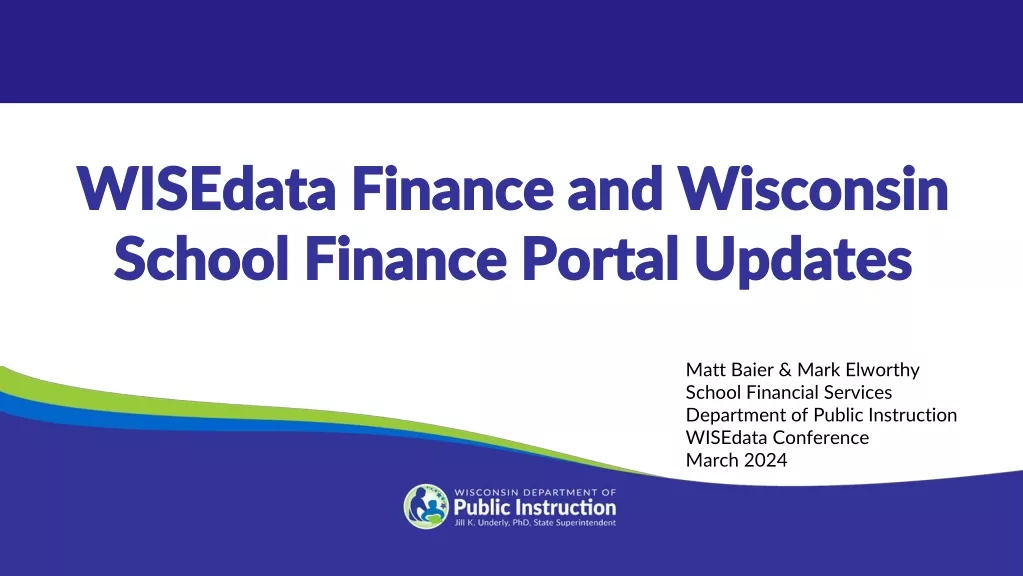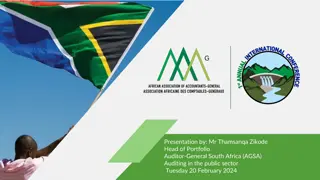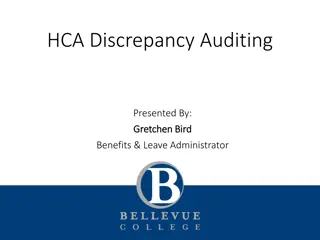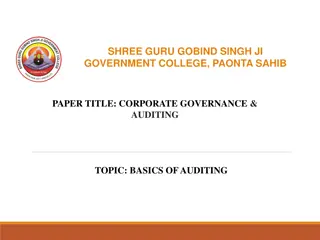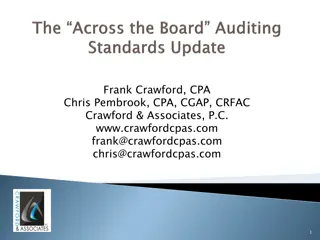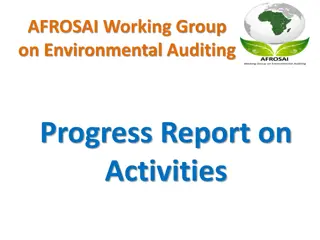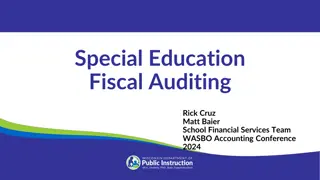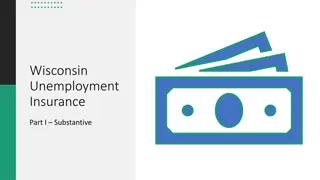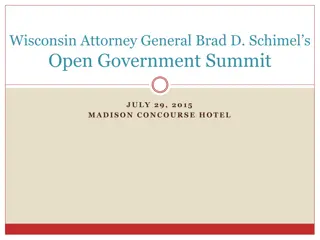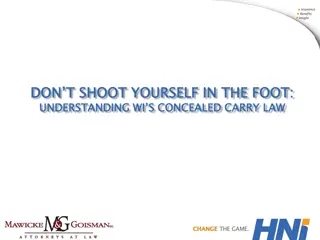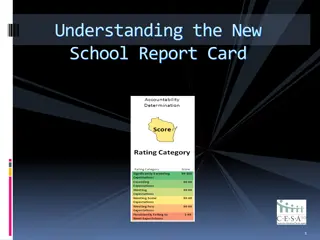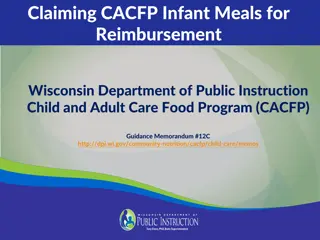Auditing Standards and Requirements in Wisconsin Department of Public Instruction
Understanding the auditing standards and requirements for financial statements audits in the Wisconsin Department of Public Instruction, including the role of management, statements on auditing standards, independence criteria, technical training needed for auditors, and services performed by independent auditors.
Download Presentation

Please find below an Image/Link to download the presentation.
The content on the website is provided AS IS for your information and personal use only. It may not be sold, licensed, or shared on other websites without obtaining consent from the author.If you encounter any issues during the download, it is possible that the publisher has removed the file from their server.
You are allowed to download the files provided on this website for personal or commercial use, subject to the condition that they are used lawfully. All files are the property of their respective owners.
The content on the website is provided AS IS for your information and personal use only. It may not be sold, licensed, or shared on other websites without obtaining consent from the author.
E N D
Presentation Transcript
Brian Kahl, C.P.A. Wisconsin Department of Public Instruction
General Auditing Standards What is an Audit? What is Required? State Statutes Wisconsin Administrative Code Wisconsin Department of Public Instruction OMB Circular A-133/Omni-Circular State Single Audit Guidelines Role of Management and the Auditor Statement on Auditing Standard # 108
Management Representations Statement on Auditing Standard # 85 Statement on Auditing Standard # 117 Required Communications Statement on Auditing Standard # 114 Communicating Internal Control Matters Statement on Auditing Standard # 115 Consideration of Fraud in a Financial Statement Audit Statement on Auditing Standard # 99 Financial Statements
The Clarified auditing standards incorporates all SASs issued beginning with SAS # 122 and should be used for audits of financial statements for periods ending on or after December 15, 2012 SAS # 108 (AU-C Section 210) SAS # 85 (AU-C Section 580) SAS # 114 (AU-C Section 260) SAS # 115 (AU-C Section 265) SAS # 99 (AU-C Section 240)
What services can an independent auditor perform?
The auditor must maintain independence in mental attitude in all matters related to the audit. To be independent the auditor must be intellectually honest: to be recognized independent, he must be free from any obligation to or interest in the client, its management, or owners. Independent auditors should not only be independent in fact; they should avoid situations that may lead outsiders to doubt their independence.
The auditor must have adequate technical training and proficiency to perform the audit. Including knowledge of government auditing standards. Understanding of the environment in which Wisconsin school districts operate (including DPI reporting requirements).
An examination of records or financial accounts to check their accuracy. An inspection, correction, and verification of accounts. Each year they audit our accounts and certify them as true and fair.
An audit includes examining, on a test basis, evidence supporting the amounts and disclosures in the financial statements. An audit also includes assessing the accounting principals and significant estimates made by the District s Board of Education and management, as well as evaluating the overall financial statement presentation.
Types of Audits Financial Statement audits are designed to provide users of financial reports with assurance concerning their reliability Attestation engagements are designed to provide assurance on matters other than financial reports Performance audits are designed to determine whether governmental programs and activities are meeting stated goals and objectives, and to determine if governments are performing duties in the most economic and efficient matter possible.
A financial audit, or more accurately, an audit of financial statements, is the verification of the financial statements of a legal entity, with a view to express an audit opinion. An audit is not designed to detect error or fraud that is immaterial to the financial statements.
Auditors have traditionally provided a range of nonaudit services that are consistent with their skills and expertise to entities at which they perform audits. Providing such nonaudit services may create threats to an auditor s independence.
Nonaudit Services Preparing Financial Statements Maintaining the Capital Asset Record Preparing Journal Entries Performing Reconciliations Does providing the nonaudit service create a threat to independence? Consideration of management s ability to effectively oversee the nonaudit service to be performed (this is a critical component of the determination)
The auditor should determine that the audited entity has designated an individual who possesses suitable skill, knowledge, or experience and that the individual understands the services to be performed sufficiently to oversee them The individual is not required to possess the expertise to perform or reperform the services Reviewing, approving, and taking responsibility for the financial statements
Wisconsin Statute 120.14 (1) At the close of each fiscal year, the school board of each school district shall employ a licensed accountant to audit the school district accounts and certify the audit The audit shall include information about expenditures for community programs and services If required by the state superintendent under statute 115.28(18), the audit shall include the number of pupils reported for membership purposes under statute 121.004(5)
Wisconsin Statute 120.18(1) Annually at such time as the department prescribes but after the end of the school year and no later than September 1, the school district clerk of a common or union high school district shall file a verified annual school district report with the department, on forms supplied by the department. PI 1505 AC "Annual Report - Aid Certification".
Wisconsin Statute 120.14 (1) Annually by September 15, the school district clerk shall file a financial audit statement with the state superintendent. Auditors file a Financial Audit Statement PI-1506 form.
Wisconsin Statute 115.28 (18) Pupil Membership Audits. Annually require at least 25% of school boards to audit the number of pupils reported for membership purposes under statute 120.14 (1) Wisconsin Statute 120.14 (4) The department shall establish by rule a standard contract and minimum standards for audits performed under this section.
Wisconsin Administrative Code, PI 14 Establishes Minimum Standards for School District Audits Auditor shall conduct an examination of the basic financial statements including all funds of the school district for the fiscal year Generally accepted audit standards United States office of management and budget (OMB) Circular A-133 Standards for financial and compliance audits contained in the standards for audits of governmental organizations, programs, activities, and functions issued by the comptroller general of the United States (Yellow Book).
Wisconsin Administrative Code, PI 14 Financial statements presented in the auditor s report shall comply with generally accepted accounting principals (GAAP) The auditor shall express an opinion on the financial statements of all funds covered in the scope of the audit. If the auditor is unable to express an unqualified opinion, the auditor shall state fully the reasons for qualification or disclaimer of opinion. The school district shall correct any deficiency which results in a qualification or disclaimer of opinion
Unqualified Qualified Adverse Disclaimer of Opinion
Wisconsin Administrative Code, PI 14 The auditor shall submit to the school board the following reports and shall supply copies for transmittal to the department and other agencies as may be required under applicable statutes or rules. Auditor s report on the school district s financial statements prepared according to generally accepted accounting principles, as promulgated by the governmental accounting standards board, with supplemental information as required by the department or requested by the district Financial audit statement for the fiscal year Management letter
Wisconsin Administrative Code, PI 14 Federal program audit reports and schedules, as appropriate State program audit reports and schedules, as appropriate Membership audit report, if required by the department under statute 115.28 (18)
Wisconsin Administrative Code, PI 14 Standard School District Audit Contract The school board may utilize the standard school district audit contract format prescribed by the department in the appendix to this chapter. If the school board does not utilize the format prescribed by the department it shall ensure that the contract contains all the provisions in sub. (2) and all of the following provisions: It shall specify the compensation agreed upon between the school board and the auditor including an estimate as to the total cost of the audit provided by the auditor It shall specify terms of payment
Wisconsin Administrative Code, PI 14 It shall be signed by both of the following: A school district officer who is authorized by the school board to enter into a contractual agreement The owner or partner of the audit firm Noncompliance with Minimum Standards for Audit Any audit which the department determines is not in compliance with this section shall be referred to the school district for corrective action.
Wisconsin Department of Public Instruction Requirements The department shall establish by rule a standard contract and minimum standards for audits (statute 120.14 (4)) Auditors are required to follow the applicable audit procedures contained in the DPI audit manual located at http://sfs.dpi.wi.gov/sfs_aud_list . The DPI manual contains guidance on auditing the following: Transportation Aid Special Education Aid General Aid Pupil Activity Funds Employee Benefit Trust Funds Compliance with State Statutes
Circular No. A-133 Non-Federal entities that expend $500,000 or more in a year in Federal awards shall have a single or program-specific audit conducted for that year in accordance with the provisions of Circular A-133. Districts must ensure that the audits required by Circular A-133 are properly performed and submitted when due.
Circular No. A-133 The auditee shall also prepare a schedule of expenditures of Federal awards for the period covered by the auditee's financial statements. The auditor is required to prepare a schedule of findings and questioned costs. The auditee is responsible for follow-up and corrective action on all audit findings. The auditee shall also prepare a corrective action plan for current year audit findings.
The corrective action plan shall provide: The names of the contact person(s) responsible for the corrective action The corrective action planned The anticipated completion date If the auditee does not agree with the audit findings or believes corrective action is not required, then the corrective action plan shall include and explanation and specific reasons
State Single Audit Guidelines The State Single Audit Guidelines are applicable to a school district audit if all three conditions are met: The agency is a local government or a non profit organization that expended $500,000 or more in federal awards. The agency received funding from a state department. This funding may be state money or federal pass-through money. The granting agency has not otherwise specified that the Guidelines are not applicable.
State Single Audit Guidelines The audit report must include a Corrective Action Plan for all audit findings, including findings related to state and federal pass-through programs. The auditee is responsible for ensuring that each granting agency receives the complete audit reporting package.
Establishing an Understanding With the Client The auditor should establish an understanding with the client regarding the services to be performed for each engagement. The auditor should document the understanding through written communication with the client. Such an understanding reduces the risk that either the auditor or the client may misinterpret the needs or expectations of the other party.
The understanding should include: the objectives of the engagement management responsibilities the auditor s responsibilities limitations of the engagement
An understanding with the client regarding an audit of the financial statements generally includes the following matters: The objective of the audit is the expression of an opinion on the financial statements. At the conclusion of the engagement, management will provide the auditor with a letter that confirms certain representations made during the audit.
Management is responsible for the following: the entity s financial statements and selection and application of the accounting policies. establishing and maintaining effective internal control over financial reporting. designing and implementing programs and controls to prevent and detect fraud.
Management is responsible for the following: identifying and ensuring that the entity complies with the laws and regulations applicable to its activities making all financial records and related information available to the auditor
The auditor is responsible for conducting the audit in accordance with generally accepted auditing standards. Those standards require the auditor obtain reasonable assurance rather than absolute assurance about whether the financial statements are free of material misstatement, whether caused by error or fraud. Accordingly, a material misstatement may remain undetected.
Management is responsible for adjusting the financial statements to correct material misstatements affirming to the auditor in the management representation letter that the effects of any uncorrected misstatements aggregated by the auditor during the current engagement and pertaining to the latest period presented are immaterial, both individually and in the aggregate, to the financial statements taken as a whole
On recurring audits, the auditor should assess whether circumstances require the terms of the audit engagement to be revised. If the auditor concludes that the terms of the preceding engagement need not be revised for the current engagement, the auditor should remind management of the terms of the engagement and the reminder should be documented.
The auditor may remind management of the terms of the engagement in writing or orally. A written reminder might be a letter confirming that the terms of the preceding engagement will govern the current engagement. If the reminder is oral, audit documentation may include with whom the discussion took place, when, and the significant points discussed.
This section establishes a requirement that an independent auditor obtain written representations from management. Specific representations should relate to the following matters in an audit of financial statements presented in accordance with generally accepted accounting principals. Financial statements Completeness of Information Recognition, measurement, and disclosure Subsequent events
This section is a applicable when the auditor is engaged or is required by law or regulation to perform a compliance audit in accordance with all of the following: Generally accepted auditing standards (GAAS) The standards for financial audits under Government Auditing Standards A governmental audit requirement that requires an auditor to express an opinion on compliance The auditor should request from management written representations that are tailored to the entity and the governmental audit requirement.
This section establishes standards and provides guidance to auditors in fulfilling the responsibility to plan and perform the audit to obtain reasonable assurance about whether the financial statements are free of material misstatement as it relates to fraud in an audit of financial statements accordance with generally accepted auditing standards. financial statements are free of material misstatement as it relates to fraud in an audit of financial statements conducted in
Fraud is a broad legal concept and auditors do not make legal determinations of whether fraud has occurred. Rather the auditor's interest specifically relates to acts that result in a material misstatement of the financial statements.
The primary factor that distinguishes fraud from error is whether the underlying action that results in the misstatement of the financial statements is intentional or unintentional. For purposes of the section, fraud is an intentional act that results in a material misstatement in financial statements that are the subject of an audit.
Two types of misstatements are relevant to the auditor's consideration of fraud. misstatements arising from fraudulent financial reporting misappropriation of assets
Fraudulent financial reporting may be accomplished by the following: Manipulation, falsification, or alteration of accounting records or supporting documents from which financial statements are prepared Misrepresentation in or intentional omission from the financial statements of events, transactions, or other significant information Intentional misapplication of accounting principles relating to amounts, classification, manner of presentation, or disclosure
Misstatements arising from misappropriation of assets involve the theft of an entity's assets where the effect of the theft causes the financial statements not to be presented, in all material respects, in conformity with GAAP. Misappropriation of assets can be accomplished in various ways including embezzling receipts stealing assets causing an entity to pay for goods or services that have not been received
The auditor has a responsibility to plan and perform the audit to obtain reasonable assurance about whether the financial statements are free of material misstatement, whether caused by error or fraud.
Management is responsible 1)-for adopting sound accounting policies 2)-for establishing and maintaining internal control that will, among other things, authorize, record, process, and report transactions (as well as events and conditions) consistent with management's assertions embodied in the financial statements


